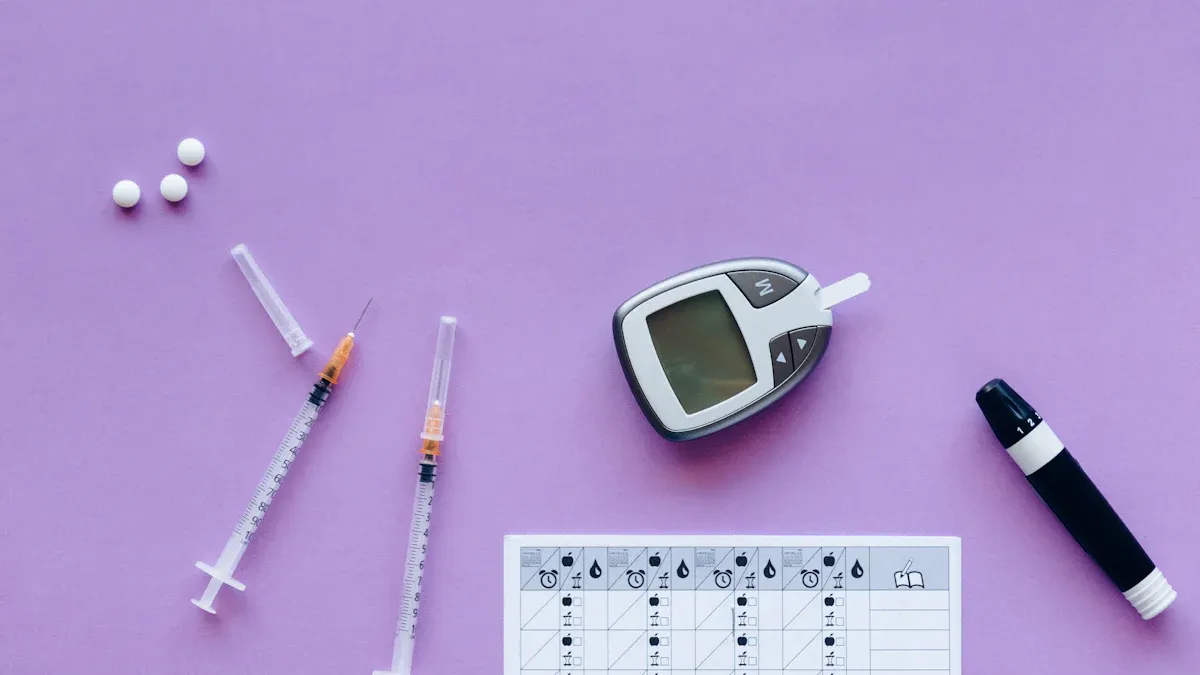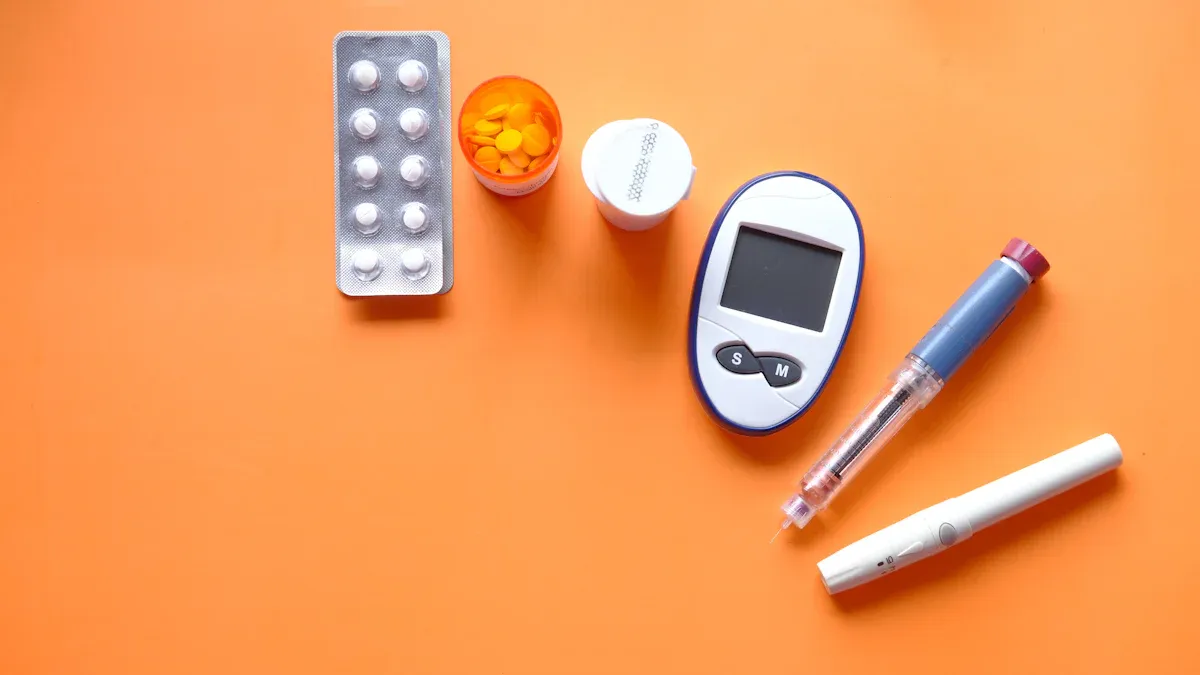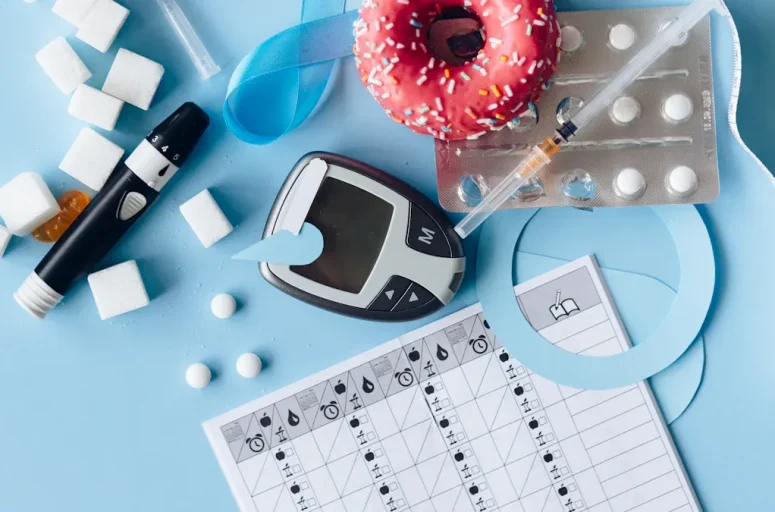
If you have diabetes, you may know about antioxidants. One important antioxidant is alpha-lipoic acid, which is produced by your body. The alpha-lipoic acid benefits include its ability to fight oxidative stress, which can damage cells and exacerbate diabetes. Research indicates that taking 600 mg daily can enhance insulin sensitivity, aiding in the control of blood sugar levels in your body. Additionally, alpha-lipoic acid contributes to overall health and wellness.
Key Takeaways
Alpha-lipoic acid (ALA) is a strong antioxidant that fights cell damage. It is helpful for people with diabetes.
Taking 600 mg of ALA each day can make insulin work better. This helps control blood sugar levels.
ALA is in foods like red meat, spinach, and broccoli. But supplements give a stronger amount.
Studies show ALA can reduce nerve pain caused by diabetes. This helps many people feel better.
ALA lowers swelling in the body and may help the heart and metabolism.
Talk to your doctor before using ALA supplements, especially if you have diabetes or other health problems.
Check your blood sugar often when using ALA. It might make blood sugar drop too low for some people.
Adding ALA to your daily routine can help manage diabetes and improve your health.
What is Alpha-Lipoic Acid?
Definition and Role in the Body
Alpha-lipoic acid is made naturally by your body, but only in small amounts. It helps your cells turn glucose into energy, which your body needs. What makes it special is that it works in both water and fat. This means it can help protect your whole body, unlike some antioxidants that only work in certain areas.
Another cool thing about alpha-lipoic acid is that it can recharge other antioxidants, like vitamins C and E, so they work better. It’s important to know that alpha-lipoic acid is not the same as alpha linolenic acid, which is an omega-3 fatty acid. Both are good for you, but they do different things. Studies show that alpha-lipoic acid may help lower blood sugar and improve how your body uses insulin, especially for people with diabetes.
Natural Sources of Alpha-Lipoic Acid
You can get alpha-lipoic acid from some foods, but the amounts are small. Here are some good sources:
Animal-based foods: Red meat and organ meats, like liver, have a lot of alpha-lipoic acid.
Plant-based foods: Vegetables such as spinach, broccoli, tomatoes, and Brussels sprouts are great choices. Other options include carrots, beets, yams, and potatoes.
Other sources: Brewer’s yeast and rice bran also contain alpha-lipoic acid.
Even though these foods have alpha-lipoic acid, the amount is usually too low to make a big difference. That’s why many people use supplements.
Alpha-Lipoic Acid as a Supplement
If you want more alpha-lipoic acid, supplements are an easy way to get it. They are sold in doses of 300 to 600 mg. Studies show that taking 600 mg daily can help improve insulin sensitivity and reduce nerve pain caused by diabetes.
For example, one study showed that people with diabetes who took 600 mg of alpha-lipoic acid every day had better blood sugar control and less oxidative stress. Another study found that people with diabetic nerve pain felt less pain and tingling after three months of taking it.
Supplements are useful because they give you a strong dose of alpha-lipoic acid, which is hard to get from food alone. But before starting any supplement, talk to your doctor, especially if you have diabetes or other health problems.
Alpha-Lipoic Acid and Oxidative Stress
What is Oxidative Stress in Diabetes?
If you have diabetes, you might know about oxidative stress. But what does it mean? Oxidative stress happens when your body has too many free radicals. Free radicals are unstable molecules that can harm your cells. This can lead to problems like nerve damage, eye issues, or heart disease.
Studies show oxidative stress is a big problem in diabetes:
Ferdinando Giacco et al. (2010) found that reactive oxygen species (ROS) can block enzymes needed for sugar control.
Masuko Ushio-Fukai et al. (2004) linked ROS to diabetic eye problems.
Qingzheng Kang et al. (2020) showed antioxidants can lower oxidative stress and its effects.
This means controlling oxidative stress is very important for staying healthy with diabetes.
How Alpha-Lipoic Acid Fights Free Radicals
Alpha-lipoic acid is a strong antioxidant that helps fight free radicals. It stops these harmful molecules before they damage your cells. Think of it as a shield protecting your body from harm.
Research shows alpha-lipoic acid activates Nrf2, a protein that boosts your body’s natural defenses. It also raises glutathione levels, which is one of your body’s best antioxidants. Said et al. found that alpha-lipoic acid lowers harmful fats and improves antioxidant activity in tissues.
What’s even better? Alpha-lipoic acid doesn’t just stop free radicals. It also helps other antioxidants, like vitamins C and E, work better. This makes it great for improving insulin sensitivity and keeping your cells safe.
Protecting Cells from Damage
Oxidative stress can also cause inflammation, which makes things worse. Alpha-lipoic acid helps by lowering inflammation. It blocks NF-kB, a protein that causes inflammation in the body.
It also removes free metals like iron and copper, which can create more free radicals. By doing this, alpha-lipoic acid gives extra protection to your cells.
If you have type 2 diabetes, these benefits are very helpful. By lowering oxidative stress, alpha-lipoic acid can protect your nerves, eyes, and heart. That’s why many people with diabetes use this antioxidant to stay healthier.
Alpha-Lipoic Acid Benefits for Insulin Sensitivity

Improving Insulin Sensitivity
Managing diabetes means making insulin work better. Insulin helps cells take sugar from your blood. When your body resists insulin, sugar levels rise. Alpha-lipoic acid can help. It improves how cells respond to insulin by activating helpful pathways.
Research shows alpha-lipoic acid helps people with diabetes use insulin better. In one study, taking 600 mg daily improved insulin sensitivity a lot. This means their bodies handled sugar better, keeping blood sugar steady.
By improving insulin sensitivity, alpha-lipoic acid helps control blood sugar. It also lowers risks of nerve and heart problems. A small change like this can greatly improve diabetes care.
Helping with Glucose Metabolism
Glucose metabolism is how your body turns sugar into energy. In type 2 diabetes, this process often fails. Alpha-lipoic acid helps cells use sugar better, lowering blood sugar and boosting energy.
Think of alpha-lipoic acid as a helper for your body’s energy makers, called mitochondria. It helps them work well, giving cells energy without leaving too much sugar in your blood. This prevents sugar spikes and crashes, which are bad for diabetes.
Alpha-lipoic acid also reduces oxidative stress, which can harm glucose metabolism. By doing both—lowering stress and improving sugar use—it becomes a strong tool for managing diabetes.
Scientific Proof of Alpha-Lipoic Acid
Science supports alpha-lipoic acid’s benefits for insulin sensitivity. Studies show it improves how the body uses insulin. Here’s a summary:
Study Type | Sample Size | Dose Given | Result | Significant? |
|---|---|---|---|---|
Intravenous | 13 patients | 1,000 mg ALA | Yes | |
Oral | 72 patients | 600-1,800 mg ALA | 25% better insulin sensitivity in 4 weeks | Yes |
In another study, 74 diabetes patients took 600 mg daily. They showed better insulin-stimulated sugar use than those on a placebo. Higher doses didn’t work better, showing 600 mg is enough for most people.
Reviews also show alpha-lipoic acid lowers inflammation markers like IL-6 and TNF-α. These markers are often high in diabetes. This proves alpha-lipoic acid is not just an antioxidant but a helpful tool for diabetes care.
Benefits of Alpha-Lipoic Acid for Diabetes Management
Why Alpha-Lipoic Acid Helps with Diabetes
If you have diabetes, alpha-lipoic acid can really help. It makes your cells respond better to insulin. This keeps your blood sugar steady and avoids sudden highs and lows.
It also fights oxidative stress, which is common in diabetes. Oxidative stress harms cells and causes inflammation. Alpha-lipoic acid protects your cells and lowers inflammation. This helps prevent problems like nerve pain. Studies show it can ease symptoms of diabetic nerve pain, like tingling and burning. For example, one study found that nerve pain scores improved after three months of use.
Here’s a summary of some research:
Study Focus | Measurable Outcome | Result |
|---|---|---|
Nerve function in diabetes | Nerve speed and strength | Better after 30 and 60 days |
Nerve pain symptoms | Pain and tingling relief | Improved after 3 months |
Insulin sensitivity | Sugar use by cells | Better with alpha-lipoic acid |
These studies show how alpha-lipoic acid helps with both blood sugar and nerve pain.
Other Health Benefits of Alpha-Lipoic Acid
Alpha-lipoic acid isn’t just for diabetes. It helps with other health issues too. For example, it lowers inflammation, which is linked to many diseases.
Here are more ways it can help:
It supports heart health by improving blood vessel function.
It may help people with obesity by improving metabolism.
It could slow memory loss in conditions like Alzheimer’s.
It might help with autoimmune diseases like multiple sclerosis.
If you have type 2 diabetes, these extra benefits are great. By reducing inflammation and stress, alpha-lipoic acid helps you feel healthier overall.
A long-term study called NATHAN-1 showed it improves nerve pain in diabetes. Another review confirmed it lowers inflammation markers. This proves it’s good for overall health.
Whether you want to control blood sugar, reduce stress, or feel better, alpha-lipoic acid can help. It’s a great addition to your health routine.
Dosage and Safety of Alpha-Lipoic Acid
Recommended Dosage for Diabetes Management
If you want to use alpha-lipoic acid for diabetes, the right dose matters. Studies show taking 600 mg daily helps with insulin sensitivity and nerve pain. This amount improves blood sugar control without extra risks.
Experts say doses between 200 and 2,400 mg per day are safe. But higher doses don’t give better results. For nerve pain, 600 to 1,800 mg daily works well. Most research agrees that 600 mg is enough for type 2 diabetes.
Here’s a simple table of dosage advice:
Source | Dosage Range | Notes |
|---|---|---|
WebMD | 600-1,800 mg daily | Helps reduce nerve pain in three weeks. |
EBSCO | 100-1,800 mg daily | 300-600 mg daily is safe for six months. |
Natural Medicine Journal | 400 mg twice daily | Improves blood vessel health in teens with type 1 diabetes. |
Before starting alpha-lipoic acid, talk to your doctor. They can help you find the best dose for your needs and health plan.
Potential Side Effects
Alpha-lipoic acid is safe for most people, but side effects can happen. Some may feel nausea, dizziness, or an upset stomach. These problems are mild and usually go away quickly.
Rarely, it might lower blood sugar too much, causing hypoglycemia. Signs include shaking, sweating, or confusion. If this happens, check your blood sugar and call your doctor.
The good news? Studies show no major side effects, even with higher doses. For example, a study found pregnant women taking 600 mg daily had no problems. Still, it’s smart to watch how your body reacts and stay cautious.
Precautions and Who Should Avoid Alpha-Lipoic Acid
While alpha-lipoic acid is helpful, it’s not for everyone. Keep these points in mind:
If you take thyroid medicine, alpha-lipoic acid might affect it. Ask your doctor first.
Pregnant or breastfeeding women should only use it with medical advice.
If you’ve had low blood sugar before, monitor levels carefully when using it.
To stay safe, work with your healthcare team. Doctors and pharmacists can guide you on the right dose and watch for side effects. This teamwork ensures you get the benefits of alpha-lipoic acid while staying safe.
Tip: Always check with your doctor before adding new supplements. They can help you make the best choice for your health.
Alpha-lipoic acid (ALA) can help people manage diabetes better. It lowers oxidative stress, boosts insulin sensitivity, and eases nerve pain. Research supports these benefits. For instance, the NATHAN-1 study found ALA reduced nerve pain in 460 patients. A review of 24 studies showed it also improved blood sugar and fat levels.
Study Details | Results |
|---|---|
Reduced nerve pain and slowed its worsening. | |
Review of 24 studies (2018) | Better blood sugar and fat levels in metabolic syndrome. |
Study of 74 diabetes patients | Improved sugar use with 600 mg of ALA daily. |
Trial with teens with type 1 diabetes | Healthier blood vessels with ALA and antioxidant-rich foods. |
Always talk to your doctor before using ALA. When used wisely, it can be a helpful tool for managing diabetes.
FAQ
What is the best time to take alpha-lipoic acid?
Take ALA on an empty stomach, 30 minutes before eating. This helps your body absorb it better. If you take more than one dose, spread them out during the day.
Can alpha-lipoic acid cure diabetes?
No, ALA cannot cure diabetes. It helps manage symptoms like high blood sugar. It improves insulin sensitivity and lowers oxidative stress. Always pair it with healthy habits and your doctor’s advice.
Is alpha-lipoic acid safe for long-term use?
Yes, ALA is safe for most people when used correctly. Long-term use should be monitored by a doctor. This is especially important if you have health issues or take other medicines.
Can I get enough alpha-lipoic acid from food?
Foods like spinach, broccoli, and red meat have ALA, but only in small amounts. Supplements are needed to get enough ALA for noticeable benefits.
Does alpha-lipoic acid interact with medications?
Yes, ALA can interact with thyroid medicine or insulin. It may also lower blood sugar too much. Always ask your doctor before using ALA with other medications.
Can alpha-lipoic acid help with diabetic nerve pain?
Yes, ALA can reduce nerve pain, tingling, and burning in diabetes. Studies show taking 600 mg daily improves symptoms within weeks.
Are there any side effects of alpha-lipoic acid?
Some people may feel mild nausea, dizziness, or stomach upset. Rarely, it can cause very low blood sugar. If you notice unusual symptoms, stop taking ALA and call your doctor.
Who should avoid taking alpha-lipoic acid?
Pregnant or breastfeeding women, people with thyroid problems, or those with low blood sugar should avoid ALA unless a doctor says it’s okay. Always check with a healthcare provider first.
Tip: Write down how ALA affects your blood sugar and health. This helps you and your doctor make changes if needed.


